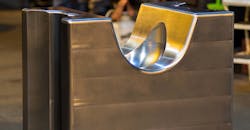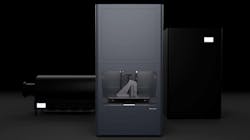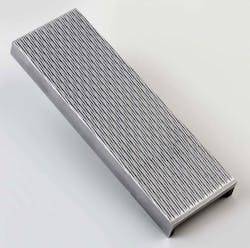Simplifying the Complexity of Hard Materials
Die forging seems so simple: just force the raw material to conform to the desired shape. And when this is demonstrated it looks simple, too, but what looks simple is the result of numerous considerations, calculations, and decisions, many of these concerning the materials used in the process, meaning the materials forming the molds as well as the workpieces.
It’s only when the simplicity is revealed as complexity, or even inefficiency, that the challenges of impression-die forging begin to take shape.
“Good machinability and consistently homogeneous material properties are the prerequisite for demanding forging processes,” according to Finkl Steel, which develops tool steels for die forging as well as forged parts. It holds over 100 patents for steel grades and steelmaking processes, and supplies tool and die steels to forgers and other manufacturers.
For forgers, machinability ensures that the material hard enough to absorb hundreds or thousands of high-impact blows can be formed with sufficient accuracy to impart a precise shape to the workpiece. And, homogeneity ensures that the tooling material will not crack or degrade under prolonged heat or force.
This just hints at the complexity of selecting and applying tool and die steels, and yet the lure of “simplicity” is strong, especially for problem-solving engineers and the investors that finance their work. From a die forgers’ perspective, this may be the best way to understand the steady approach of additive manufacturing technologies.Additive manufacturing (sometimes called 3D printing, or 3DP) is a burgeoning business sector, mainly in the commercial sense: systems are designed for desktops, labs, workshops, or plants, so anyone can be a manufacturer on the scale he selects. The technological progress of AM is particularly notable for prototyping, and for plastic and ceramic parts, but the success of producing AM metal parts depends mainly on the material. While there have been significant accomplishments in the production of complex metal shapes (e.g., turbine blades, fuel nozzles), “printing” hard materials is still on the horizon.
But that horizon may be approaching. Earlier this year, Markforged introduced a “breakthrough technology” in metal additive manufacturing called Atomic Diffusion Additive Manufacturing, and a system for that process called Metal X. Markforged already offers several 3D printing systems for producing carbon-fiber composite parts. Metal X will print stainless steel parts (17-4 and 303), and the developer emphasized that injection-mold materials will be possible soon.
Metal X works with metal powders (aluminum and titanium alloys, as well as stainless grades) encased in a plastic binder that dissolves after “printing,” and then the entire completed shape is sintered to solidify the final composition. This is said to be part of the advantage of the process, because it allows the metal to crystallize across the layered structure inherent to additive manufactured parts, which helps to achieve the metallurgical density that is necessary for hard materials.
Metal X also offers a large build platform (250mm×220mm×200mm), which is further advantageous to producing molds.
“Until today, the story of metal 3D printing has been million-dollar machines that fill a room,” stated CEO Greg Mark in January. “With the introduction of the Metal X, metal production is easier and more available than ever. Manufacturers and machine shops looking to augment CNC machining or find alternatives now have an answer.
“This revolution is not just about making metal parts – it’s also about making plastic parts from a 3D-printed metal mold created in days, instead of months,” Mark added. Of course, he is not describing forging molds, but if the technology succeeds then it merely awaits the emergence of the right material.One recently introduced material is BLDRmetal™ L-40, a casehardening steel powder that provides high hardness and ductility (case hardness >70HRC, 10%+ core elongation), and prints on standard metal printers. It was introduced by NanoSteel, a developer of nanostructured steel materials for laser powder-bed fusion additive manufacturing. The new alloy reportedly performs better than M300 maraging steel and is designed to be used for tools, dies, bearings and gears.
NanoSteel demonstrated BLDRmetal L-40 by printing an 8-in. thread-rolling die set, noting it outperformed dies machined from D2 and M2 tool steels. (Thread rolling is a cold forging process.) “We tried nearly every combination of material and conventional CNC machining process to create our dual-thread die sets, none of which could cut or grind the complicated dual-thread geometry,” reported Mark Doll, president and CEO of Perfect Lock Bolt America Inc., a manufacturer of dual-thread fasteners.
“The NanoSteel solution delivers exactly what we are looking for, including excellent surface finish, flexibility, as well as strength and hardness for maximum die life,” he said.
NanoSteel developed the hard alloy through rapid iterative development at CFK GmbH, a 3D printing service provider. “For us, the most important attributes of NanoSteel’s BLDRmetal L-40 are that it is easily implemented and creates crack-free, high-hardness components, which sets it apart from the many other tool steels we have tested,” said CFK’s Dr-Ing. Christoph Over, CEO.
“Launching BLDRmetal L-40 after successfully producing the roll-thread dies ensures the commercial viability of the new alloy for customers investigating the use of additive manufacturing,” according to NanoSteel’s vice president and general manager, Harald Lemke. “We don’t stop at material design, but create joint solutions with our customers, facilitating the process from material selection and prototyping to fully qualified production parts.” Soon, die forgers may be among those co-developers.


